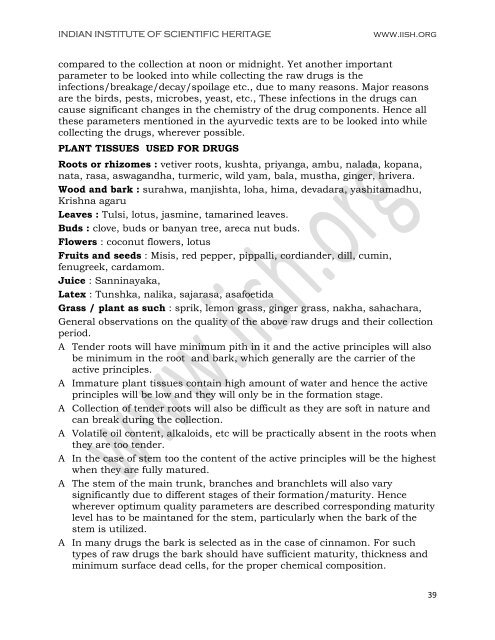Download free book on ayurvedic drugs - healthy family, happy family
Download free book on ayurvedic drugs - healthy family, happy family
Download free book on ayurvedic drugs - healthy family, happy family
Create successful ePaper yourself
Turn your PDF publications into a flip-book with our unique Google optimized e-Paper software.
INDIAN INSTITUTE OF SCIENTIFIC HERITAGE www.iish.org<br />
compared to the collecti<strong>on</strong> at no<strong>on</strong> or midnight. Yet another important<br />
parameter to be looked into while collecting the raw <strong>drugs</strong> is the<br />
infecti<strong>on</strong>s/breakage/decay/spoilage etc., due to many reas<strong>on</strong>s. Major reas<strong>on</strong>s<br />
are the birds, pests, microbes, yeast, etc., These infecti<strong>on</strong>s in the <strong>drugs</strong> can<br />
cause significant changes in the chemistry of the drug comp<strong>on</strong>ents. Hence all<br />
these parameters menti<strong>on</strong>ed in the <strong>ayurvedic</strong> texts are to be looked into while<br />
collecting the <strong>drugs</strong>, wherever possible.<br />
PLANT TISSUES USED FOR DRUGS<br />
Roots or rhizomes : vetiver roots, kushta, priyanga, ambu, nalada, kopana,<br />
nata, rasa, aswagandha, turmeric, wild yam, bala, mustha, ginger, hrivera.<br />
Wood and bark : surahwa, manjishta, loha, hima, devadara, yashitamadhu,<br />
Krishna agaru<br />
Leaves : Tulsi, lotus, jasmine, tamarined leaves.<br />
Buds : clove, buds or banyan tree, areca nut buds.<br />
Flowers : coc<strong>on</strong>ut flowers, lotus<br />
Fruits and seeds : Misis, red pepper, pippalli, cordiander, dill, cumin,<br />
fenugreek, cardamom.<br />
Juice : Sanninayaka,<br />
Latex : Tunshka, nalika, sajarasa, asafoetida<br />
Grass / plant as such : sprik, lem<strong>on</strong> grass, ginger grass, nakha, sahachara,<br />
General observati<strong>on</strong>s <strong>on</strong> the quality of the above raw <strong>drugs</strong> and their collecti<strong>on</strong><br />
period.<br />
A Tender roots will have minimum pith in it and the active principles will also<br />
be minimum in the root and bark, which generally are the carrier of the<br />
active principles.<br />
A Immature plant tissues c<strong>on</strong>tain high amount of water and hence the active<br />
principles will be low and they will <strong>on</strong>ly be in the formati<strong>on</strong> stage.<br />
A Collecti<strong>on</strong> of tender roots will also be difficult as they are soft in nature and<br />
can break during the collecti<strong>on</strong>.<br />
A Volatile oil c<strong>on</strong>tent, alkaloids, etc will be practically absent in the roots when<br />
they are too tender.<br />
A In the case of stem too the c<strong>on</strong>tent of the active principles will be the highest<br />
when they are fully matured.<br />
A The stem of the main trunk, branches and branchlets will also vary<br />
significantly due to different stages of their formati<strong>on</strong>/maturity. Hence<br />
wherever optimum quality parameters are described corresp<strong>on</strong>ding maturity<br />
level has to be maintaned for the stem, particularly when the bark of the<br />
stem is utilized.<br />
A In many <strong>drugs</strong> the bark is selected as in the case of cinnam<strong>on</strong>. For such<br />
types of raw <strong>drugs</strong> the bark should have sufficient maturity, thickness and<br />
minimum surface dead cells, for the proper chemical compositi<strong>on</strong>.<br />
39


